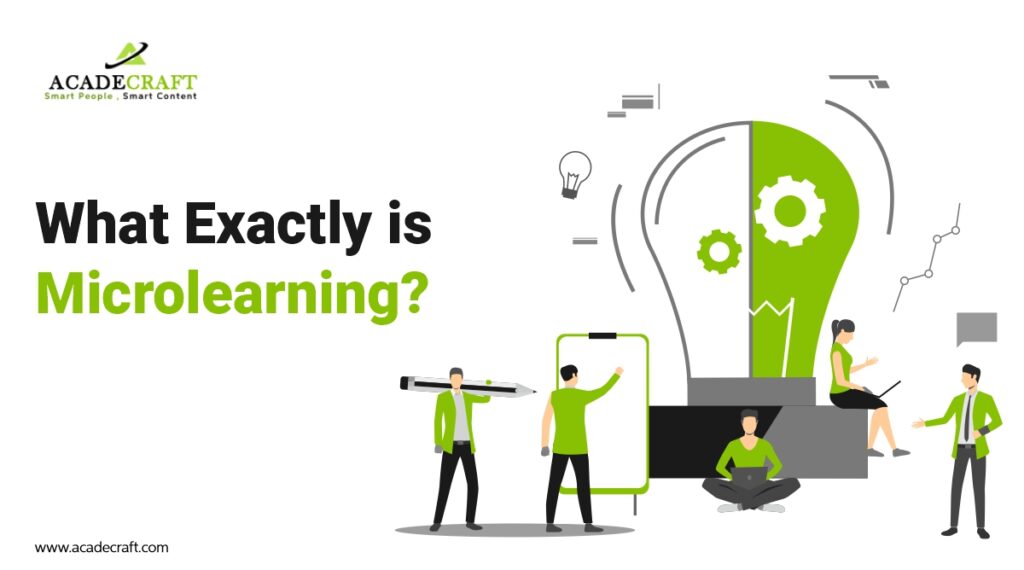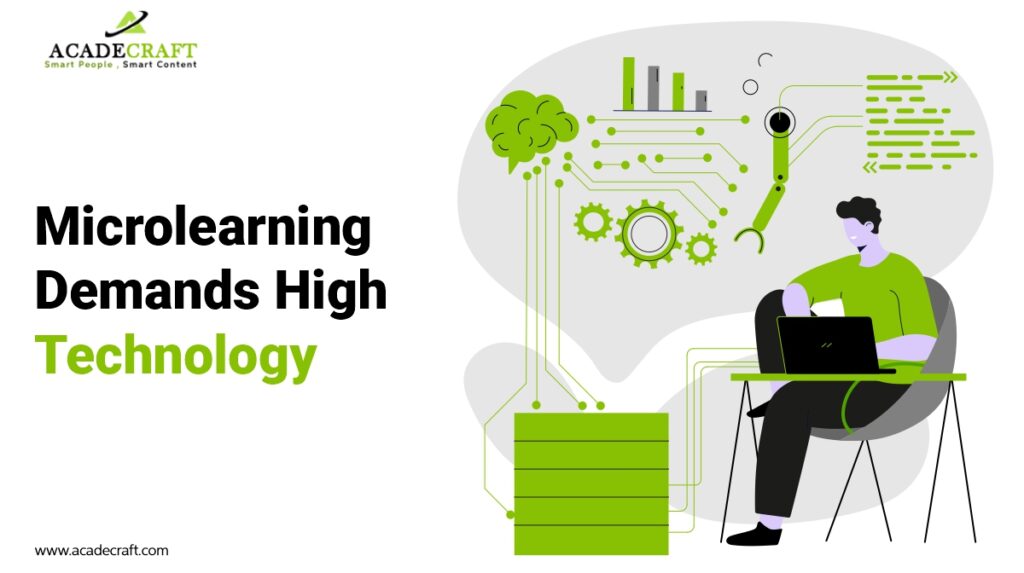We often fall victim to myths! It’s only because we hear them from here and there. Or maybe sometimes the internet provides us with false information.
Are you an institute willing to implement microlearning? But, something is holding you back? Is it the myths about microlearning? Worry no more! As we have got you covered.
Today, microlearning is a hyped word in the e-learning field. According to recent reports, microlearning increases learning engagement from an average of 15% to 90%.
Also, there are numerous mythconceptions regarding what it is and what it is not.
This blog highlights the things you need to know about microlearning and the 5 deadly myths about it.
What Exactly is Microlearning?

According to experts, “microlearning is the short version of the content that guides people to achieve their learning goals. Here, the information is targeted towards a specific audience and topic. This makes it more effective.”
In simple words, microlearning is delivering byte-sized content with Virtual Realty Services to the audience. Furthermore, it is the way of learning and not learning done to you.
Microlearning is best for:
- A quick revision
- Just in time learning
- Online quizzes and interactive multimedia presentations
- Empowering learners at their convenience
In addition, it completely emphasises context, support, and outcome. Since it is brief in nature, you must focus on your target audience appropriately.
Take a Quick Look at the Microlearning Statistics
Before we debunk the myths of microlearning, take a look at its statistics and how popularly it is growing,
- A micro lesson takes about 5 to 7 minutes to complete on average.
- The knowledge retention rate of microlearning courses is 70% to 90% when compared to traditional learning, which is 15%.
- Human memory can store up to 5 pieces of information before it gets overwritten.
- A whopping 90% of e-learners prefer short-form modules.
- It reduces training costs by 50% and increases development speed by 300%.
Microlearning: Is it Just a Simple Text or an Activity?
Only knowing about microlearning’s definition will not suffice. To quench your thirst, it is essential to know what constitutes it.
Microlearning is anything from just a simple text, an activity, video, questions, tweet, or blog. Such resources are easily accessible via web browsers. This means it is always available at our fingertips. Learners can access the content whenever they want it. Thus, gaining complete control over it.
Living in a fast-paced digitalized world, having a short-term memory is common. This is why the following strategies are used for better memory,
- Repetition of content and reinforcement to build memory.
- Use of small chunks of learning for repetition of key points.
- Daily practice enhances memory power.
- Forcing the brain cell to recall information with retrieval practice.
- Daily short assessments to build confidence.
- Acknowledging what the learners know rather than focusing on what they don’t.
Thus, microlearning is not just a simple text or activity but much more than that. So, why wait when you can provide easily accessible content to your learners?
Here are the 5 Noxious Myths of Microlearning
Let’s debunk the 5 noxious myths of microlearning. Check them out now!
- Microlearning Focuses on Time Durations
It’s a complete no! Microlearning is not time-dependent. It is short and sweet, but there is no limit to duration. Moreover, it emphasises more on what works best. The present reality depicts that if you want to remain abreast, you must stay up learning.
Microlearning allows one to access information without making pressurising their capacity to retain it. And this is what every learner is looking for today! Also, the learning needs to be as long as necessary and as short as possible.
Here is why people often lose focus,
- Interruptions via messages, phone calls or emails.
- With the passing of generations, people’s attention spans are becoming shorter and shorter.
- People have a selective memory that only captures the best and most interactive part of learning.
The main point is we often need learning that takes less amount of time. Besides, it must focus on providing useful information before we lose focus.
Hence, more than duration, microlearning is all about focus. It is all about keeping the learners engaged for a certain period of time that is both practical and effective for them.
- Microlearning Demands High Technology

Your institute holds the power of production, which is the smartphone. Earlier, expensive equipment was necessary to produce a video. But today, with the emergence of mobile, producing a video has become less costly and easy.
Even though it’s better to produce e-learning content on laptops, why not make use of the technology available in hand?
Let’s take an example, how often have we stopped an online video in between, only because the audio was worse, rather than the filming. Here, a less-cinematographic quality is acceptable.
Ensure to provide micro-learning content in the following way,
- To those who need it
- When they need it, which is just in time learning
- In a certain way, for them to retain it
Concentrate on these two questions while building a microlearning course,
- Does it meet the learning objectives?
- Is it accurate and clear?
Thus, if it encourages the learners, then it will meet the learning objectives. Furthermore, it is proven that microlearning doesn’t demand high-technology but something that retains the learners till the end.
- Microlearning is Similar to Chunking
This is saying like all carnivores are the same. Microlearning and chunking have their existence in the eLearning platform, and they are not the same!
So, what is chunking?
Chunking breaks down long-form content into byte-sized elements to manage the entire cognitive load. It is indeed a good thing.
But, coming back to microlearning, it is those content pieces that emphasise relevancy and focus. It can also be used to augment macro content. Here, separating the chapters of a book can be termed as chunks. One needs to consume these sequentially to gain value.
Microlearning, on the other hand, provides specific information in one go. Thus, it is completely different from chunking. Hence, this myth is debunked.
- Microlearning is Easy to Create
Nothing is easy in this world. A content creation process involves a tough journey. And it consumes both time and energy. Microlearning modules are usually short and precise, yet the end product will not be a simple process.
Consider the following pointers,
- Editing written content takes much longer time than the writing process.
- Designing an infographic consumes way more time than the ideas that go behind it.
- Shooting a video takes less time, but the editing procedure is time-consuming.
- Original raw recording won’t take much time, but voice editing takes double the time. Since everything needs to be synchronized.
In addition, microlearning can be small, but it needs a proper strategy and development plan. But don’t make this scare you. Remember, a proper approach always needs strategic learning.
Companies that provide microlearning or mobile learning services examine the macro content and strip it down. A microlearning course is basically a journey, bringing a user from point to point with a beginning, middle, and end with the end result. Moreover, it is much easy to say than making it done.
Thus, microlearning is not easy-peasy. The learning modules need to be concise. Here, we are talking about just-in-time learning that needs to be applied on the spot.
- Microlearning Completely Depends on Videos
Microlearning deals with performance support and that is more than just video production. For instance, let’s talk about infographics, here you can present the learner’s huge chunks of data with easily consumable and visually compelling images. Thus, video is just an addition to present your microlearning module.
Remember, micro-videos are not the overall subject matter experts talking for 2 hours and chunking that video within 15 to 30 minutes. This idea is completely insane. The main point here is to generate content that serves the purpose immediately.
Experts suggest that except videos many other things can be included. It is about providing low tech content like wallet cards, learning aids, decision trees, infographics or checklists.
Let’s take another example for better understanding,
- Infographics are visually appealing. This enables learners to easily consume the content.
- Audio clips promote collaboration. This creates a library that allows future learners to learn.
- People can walk through problem-solving issues through the decision tree.
Again, for instance, if someone is looking for an instructional guide, the video will become helpful. But, a reader might look for text-based content. A salesperson may look for infographics. Hence, it all depends upon the purpose of the moment.
Halt for a Moment
Lastly, we have reached the end of this blog. Let’s halt for a moment and ponder upon one fact. Microlearning is all about keeping the learning procedure short and crisp. And learners with little patience tend to love this learning method.
So, we have finally busted the myths. Hope this above-mentioned information have served your purpose. Make sure to use microlearning effectively and grab the attention of the learners.
Hence, don’t wait any longer. Pin your faith on Acadecraft. We have a firm foothold in the e-learning industry with a team that provides exceptional microlearning services. Get in touch with us today to skyrocket your institute instantly.







